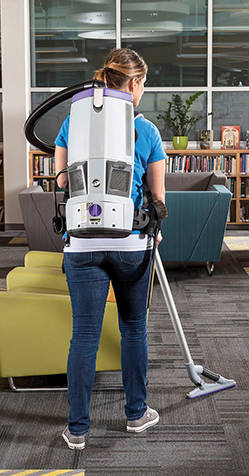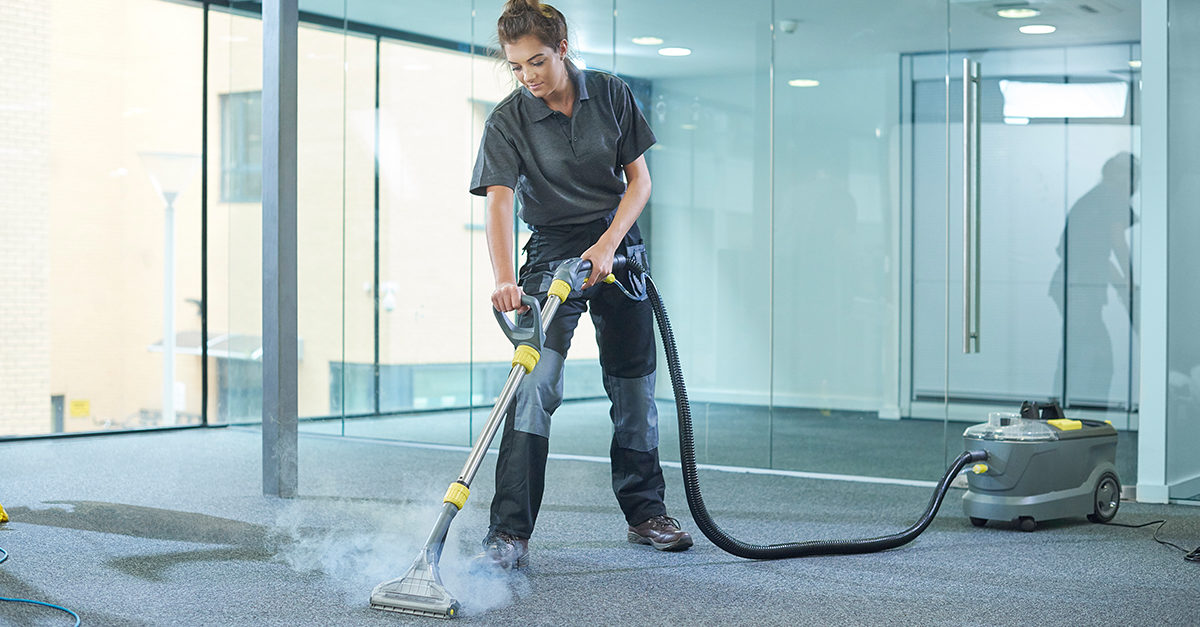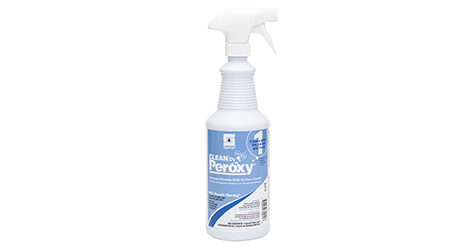Dirty carpet is not always noticeable, as soils can hide deep in the fibers below the carpet’s surface where they are “out of sight and out of mind.” However, Jim Flieler, of Charlotte Products Ltd., reminds us that carpet care is critical to employee wellness, indoor air quality, allergen control, and the projection of a clean facility image. Knowledge of new best practices, equipment, tools, and trends is vital for all these reasons.
“Attention is typically spent chasing visual surface debris,” said Flieler, who is sales and marketing vice president of the company’s Canada division. “If we review past industry cleaning processes with today’s, there has been little change with the exception of an encapsulating-type cleaner and some equipment.”
Flieler said most recent developments have come about by following what he calls the five critical elements of a professional carpet care program: pre-routine, routine, interim maintenance, interim restoration, and deep restoration.
Maintenance practices, however, can’t evolve without new cleaning solutions and equipment. Within the last five years, carpet care equipment has benefited from innovations in batteries and automation, paving the way for the growing adoption of cordless vacuums and robotic vacuums. Overall, carpet care equipment is becoming more flexible, so it can be customized to the task at hand, notes ProTeam Vice President of Sales Rich Steinberg, allowing professional cleaners to solve problems that are unique to their facilities.

Cordless technology has been one of the most noticeable improvements, allowing workers to be more mobile while eliminating cord-tripping hazards. Image courtesy of ProTeam
Improvements making an impact in carpet care equipment and tools
“Fortunately, cleaning equipment and chemistry have evolved as new carpet fibers and government regulations have changed, and new-technology low-VOC formulations now clean better than ever, especially when paired with ergonomic, efficient new tools,” said Legend Brands Cleaning Solutions Specialist Pat Muller.
Truckmount carpet cleaners, used for hot water extraction, have become more reliable, powerful, and easier to use, plus they now have more features that help the technician control the job, according to Jeff Cross, ISSA Media editorial director and IICRC-approved instructor and industry trainer. Newer heat-exchange technology provides super-hot cleaning solutions compared to those of the past, he notes.
“Bristleless spotting tools that feature chamfered openings offer a gentler method to remove spots by mildly agitating fibers on delicate textiles,” said Joe Bshero, director of technical services at Whittaker Co. “Additionally, the introduction of extreme high-production A/C powered carpet machines provides facility managers with the power to clean very large open areas at cleaning rates that are budget-friendly day and night, 24/7.”
Here are some other noteworthy advances:
Green solutions
Although not necessarily new, Green Seal certified chemistry is starting to catch on as more companies are coming out with alternative products featuring this certification. “Having this equates to your sustainable commitment of health and environmental excellence,” said milliCare Technical Director Stephen Lewis .“With education about the environment growing, this really has a high ceiling for the future products.”
Encapsulation
“Chemistry has advanced with the introduction and development of encapsulating carpet cleaners,” Flieler said. “They are far superior to typical extraction cleaners as they deep clean, lift, and encapsulate dirt, soils and odor molecules, reducing that reoccurring foul, musty odor that sometimes occurs after extraction processes. Left behind is a transparent crystal that continues to draw moisture out of the carpet, lowering the dry time and odors over the long run.”
Mark Exner, Cleaning Management Institute (CMI) master trainer and IICRC-approved instructor, said this process leaves carpet looking clean longer and lessens the maintenance cycle. “By retarding resoiling, the encapsulation process makes the fibers slick to soils, making future soils more difficult to bond with the carpets’ fiber. Spots and stains are harder to reattach themselves to the carpet fiber,” he explained.
Motors
Exner also noted a movement to increase vacuum power in portables and truckmounts by utilizing alternative motors and sources. According to Jim B. Smith, an IICRC-approved instructor and a senior practicing inspector, in the past, portables only had a fraction of the vacuum power of truckmounts; now, they can have very similar strengths. “This is a real game changer for wet extraction,” he said.
Wands
Glides on carpet cleaning wands have reduced the physical stress on users, making it much easier to repeatedly pull and push a wand. “Overall, tools like this have become more ergonomic, reducing workplace injuries and saving workers from downtime,” said Legend Brands Cleaning Equipment Manager Ed Earle.
Extraction wands have improved the drying times of wet extractors, too. “In some cases, they are lowering drying times by a factor of six,” Smith said. “The science of vacuum efficiency has not been well understood and embraced. Now it has, and the results are amazing. One is better off purchasing a better wand over a bigger truckmount.”
Cordless vacuums
Cordless technology has been one of the most noticeable improvements, allowing workers to be more mobile while eliminating cord-tripping hazards. “Over the last five years cleaning equipment has finally become untethered to the wall,” said Rachel Lego, director of Channel – Commercial, TTI Floor Care North America. Lego said this progress is due to the improvements in lithium ion batteries. “We are at the point in floor care where the lithium ion battery technology is advanced enough to meet the needs of cleaning professionals and our industry can take advantage of the efficiency gains cordless affords,” she said.
New options for battery-powered vacuums include a cordless upright that operates as a corded unit while its battery charges, and a backpack unit featuring a long runtime or a shorter runtime at a lighter weight.
“These options can help professional cleaners solve problems that are unique to their facilities,” said Steinberg of ProTeam. “A school that has limited outlets in one area might choose a shorter runtime for a lighter weight. A 24-hour facility might need to remove a tripping hazard. Another facility may go cordless to clean stairs.”
Autonomous and robotic technology
According to Brady Watkins, head of commercial at SoftBank Robotics, 2019 represented a turning point for automation in the cleaning industry: “The field of cleaning robotics now isn’t trying to create “Rosie” from The Jetsons. Robots with a realistic service value are thriving, and that success boils down to addressing a single, repetitive, pervasive task.”
In carpet care, that task is vacuuming. Autonomous vacuums are freeing up workers to perform other tasks, like collecting trash or cleaning bathrooms, said Karcher Director of Training Richard Bodo. Robotic scrubbers also are more popular today, so robotic carpet extractors are probably not too far away, said Dane Gregory, national sales manager at Carpet Cleaner America.
“Looking at 2020, we’ll see an acceleration of automation across cleaning, with an increasing segment of the industry taking the step to adopt the first—and often hardest to implement—tool or service of automation, and then continuing to scale,” Watkins said.

Autonomous vacuums are freeing up workers to perform other tasks, like collecting trash or cleaning bathrooms. Image courtesy of SoftBank Robotics
The future of carpet care equipment
As this acceleration happens, it is important to note, robots today are more ‘co-bots’ working alongside people, not replacing them, said Bodo. “Robots will be tools to increase efficiency, not a way to eliminate labor.” Lewis of milliCare sees vacuuming as one of the first autonomous services that will be overwhelmingly adapted. Flieler of Charlotte Products sees innovation in this area improving carpet care in larger facilities, such as in airports and conference centers.
Lego of TTI sees the substantial growth of cordless equipment continuing to positively impact productivity, performance, convenience, and safety. “As with any new innovation introduced, the technology improves in both performance and cost as time goes on and more people adopt the solution,” said Lego. “We are finally at a point where BSCs don’t have to compromise the performance of the equipment or their budgets to improve productivity and safety.”
Battery technology will continue to have substantial gain as well. “We expect to see longer runtimes, lighter weights, and more innovative configurations to get the job done,” said Steinberg of ProTeam. “As more facilities turn to cordless equipment, the uses of the equipment will evolve. People will discover that vacuums can do a lot more in a facility without the hindrance of a cord.”
New equipment and chemistry compliance regulations will likely force changes in cleaning practices and products, too. “The key is choosing the right product that is both effective and meets the compliance mandates,” Muller of Legend Brands said. And with the fight against global pandemics at the forefront of cleaners’ minds, Flieler predicts a concentration on chemistry to disinfect and sanitize carpet surfaces for outbreak prevention.
More advances in “smart” or predictive cleaning are also on their way. “It’s easy to know where the dirtiest areas are (typically high-traffic areas), but knowing areas that don’t need to be cleaned because no one has been in there will be helpful,” said Tennant Industrial Design Manager Tou Yia Thao. “Knowing this, then cleaners can avoid cleaning unoccupied spaces and move onto more important cleaning tasks.”
“Connected cleaning” is the next technology step, according to Watkins of SoftBank. “Individual automation and robotics initiatives now present an opportunity to understand the processes and data available to cleaning professionals as adoption ramps up,” he said. “The next step will be to take these individual initiatives out of a vacuum and integrate them, finding a universal platform to allow different pieces of equipment, tools, and software to deliver insights into one operations dashboard.”
With these advances on the horizon, carpet care will be harder to ignore and a less time-consuming task that produces cleaner and smarter results.




